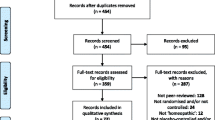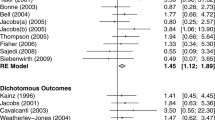Abstract
Background
Complementary therapies are widespread but controversial. We aim to provide a comprehensive collection and a summary of systematic reviews of clinical trials in three major complementary therapies (acupuncture, herbal medicine, homeopathy). This article is dealing with homeopathy. Potentially relevant reviews were searched through the register of the Cochrane Complementary Medicine Field, the Cochrane Library, Medline, and bibliographies of articles and books. To be included articles had to review prospective clinical trials of homeopathy; had to describe review methods explicitly; had to be published; and had to focus on treatment effects. Information on conditions, interventions, methods, results and conclusions was extracted using a pretested form and summarized descriptively.
Results
Eighteen out of 22 potentially relevant reviews preselected in the screening process met the inclusion criteria. Six reviews addressed the question whether homeopathy is effective across conditions and interventions. The majority of available trials seem to report positive results but the evidence is not convincing. For isopathic nosodes for allergic conditions, oscillococcinum for influenza-like syndromes and galphimia for pollinosis the evidence is promising while in other areas reviewed the results are equivocal.
Interpretation
Reviews on homeopathy often address general questions. While the evidence is promising for some topics the findings of the available reviews are unlikely to end the controversy on this therapy.
Similar content being viewed by others
Introduction
In this third part of our series on systematic reviews in complementary therapies we report our findings on homeopathy. Homeopathy is one of the most widespread forms of complementary medicine worldwide. According to a recent survey 3.4% of Americans have used homeopathy in the past 12 months [1]. It is even more widespread in some European countries [2], some countries in South America, India or Pakistan [3]. This widespread use is in strong contrast with the position held by many in scientific medicine that homeopathy has no effect beyond placebo [4].
The basic principle of homeopathy is the principle of similars: A patient with a specific pattern of symptoms is best treated by a remedy which causes the same or a very similar pattern in healthy subjects. Homoeopathic remedies are often prescribed in high dilutions some of which are unlikely to contain any molecules of the originally diluted agents. In consequence, homoeopathic remedies – at least when applied in high dilutions – cannot act by pharmacological means. Theories for a potential mechanism of action, therefore, postulate the storage of information in the dilution process by physical means [5].
Methods
A detailed description of the methods used in this review of reviews is given in the first part of this series [6]. As a specific intervention-related inclusion criterion we required that reports reviewed prospective (not necessarily controlled) clinical trials of homoeopathic medicines in humans.
Results
From a total of 22 potentially relevant reviews identified in the literature screening, 18 reviews published in 19 papers met the inclusion criteria [7–25] (see table 1). Four papers were excluded as they were only subgroup or methodological analyses of previously published papers [26–29].
Three quantitative meta-analyses addressed the general question whether homeopathy is different from placebo by pooling highly heterogeneous study samples [7–9]. Study samples and meta-analytic methods differed considerably (total number of trials covered 97). While two reviews reported significant effects of homeopathy [7,8] a third found no effect over placebo in the main analysis [9]. Several years before the publication of these studies a meta-analytic approach had already been tried in a thesis [10]. However, this review is mainly dealing with the problems encountered when trying to pool the data and cannot be interpreted meaningfully with respect to the effectiveness of homeopathy. Two older reviews included both placebo-controlled trials and comparisons with standard treatment [11,12] (total number of trials covered 107). Results were classified in a vote count as positive and negative. The majority of the studies had reported positive results. The conclusions were positive with reservations in one review and ambiguous in the other.
Two reviews focused on individualized homeopathy but were not restricted in terms of conditions investigated. A review of comparisons of individualized homoeopathic and conventional treatment found that only few trials of low quality exist [13]. The other review included mainly placebo-controlled trials [14]. Overall, the results suggested that individualized homeopathy is superior to placebo but when the analysis was limited to studies of better quality the difference was no longer significant.
Four reviews focused on a single condition or a group of conditions but included a variety of homoeopathic treatments [15–18]. Positive results have been reported for the treatment of postoperative ilues and asthma but definitive conclusions are not possible.
Arnica is the most often investigated homoeopathic remedy. Typically it is used in conditions involving tissue trauma. Two reviews with slightly different inclusion criteria have been published [19,20] (total number of trials covered 37). While the results of the available trials seem to be contradictory the more comprehensive of the two reviews had slightly more favorable conclusions.
Systematic reviews addressing more focused questions are available for the use of isopathic nosodes (diluted allergens) in allergic conditions, Oscillococcinum for influenza-like syndromes, individualized homeopathy for headache and galphimia for pollinosis [21–25]. Significant differences over placebo were reported for all but the headache review.
Discussion
Systematic reviews on homeopathy address, more often than in other areas of complementary medicine, general questions such as "is it more than placebo?" or "is it effective?" This is probably due to the fact that any effect of homeopathy over placebo is considered scientifically implausible. In consequence, the discussion does not primarily focus on specific clinical problems but on whether there is a real effect at all. While many overviews report that the majority of trial results are positive conclusions of reviewers are contradictory.
With few exceptions such as arnica for trauma or individualized homeopathy for headache, the reviews (and probably the primary research) do not cover conditions and treatment approaches which are relevant in homoeopathic practice. Self-medication with Oscillococcinum for influenza-like syndromes is popular in several countries but cannot be considered representative practice.
We want to emphasize again that it was not our primary objective to assess the effectiveness of homeopathy and the other therapies included in our series but to provide an annotated bibliography of the available systematic reviews. This provides an overall picture of the evidence but for an in-depth review readers must go back to the original reviews.
In conclusion, the available systematic reviews on homeopathy provide little guidance for patients and doctors. They rather reflect the ongoing fundamental controversy on this therapy and strengthen the perception that, on one side, positive evidence from clinical trials will not convince skeptics, and that on the other side negative results from trials not representing actual practice will not have any impact on homoeopaths.
References
Eisenberg DM, Davis RB, Ettner SL: Trends in alternative medicine use in the United States, 1990-1997. Results of follow-up national survey. JAMA. 1998, 280: 1569-1575. 10.1001/jama.280.18.1569.
Fisher P, Ward A: Complementary medicine in Europe. BMJ. 1994, 309: 101-111.
Malik IA, Khan NA, Khan W: Use of unconventional methods of therapy by cancer patients in Pakistan. Eur J Epidemiol. 2000, 16: 155-160. 10.1023/A:1007621104789.
Vandenbroucke JP: Homoeopathy trials going nowhere . Lancet. 1997, 350: 824-10.1016/S0140-6736(97)22038-6.
Schulte J: Effects of potentization in aqueous solutions. Br Hom J. 1999, 88: 155-160. 10.1054/homp.1999.0317.
Linde K, Vickers A, Hondras M: Systematic reviews of complementary therapies – an annotated bibliography. Part 1: acupuncture. BMC Complementary and Alternative Medicine. 2001, 1: 3-10.1186/1472-6882-1-3.
Cucherat M, Haugh MC, Gooch M, Boissel JP: Evidence of clinical efficacy of homeopathy. A meta-analysis of clinical trials. Eur J Clin Pharmacol. 2000, 56: 27-33. 10.1007/s002280050716.
Linde K, Clausius N, Ramirez G, et al: Are the clinical effects of homeopathy placebo effects? A meta-analysis of randomised placebo-controlled trials. Lancet. 1997, 350: 834-843. 10.1016/S0140-6736(97)02293-9.
Walach H: Unspezifische Therapie-Effekte. Das Beispiel Homöopathie. PhD thesis, Psychologisches Institut, Albert-Ludwigs-Universität Freiburg,. 1997
Lutz C: Quantitative Meta-Analyse empirischer Ergebnisse der Homöopathieforschung. Diplomarbeit, Psychologisches Institut, Albert-Ludwigs-Universität Freiburg,. 1993
Kleijnen J, Knipschild P, ter Riet G: Clinical trials of homoeopathy. BMJ. 1991, 302: 316-323.
Hill C, Doyon F: Review of randomized trials of homoeopathy. Rev Epidém et Santé Publ. 1990, 38: 139-147.
Ernst E: Classical homoeopathy versus conventional treatments: a systematic review. Perfusion. 1999, 12: 13-15. 10.1177/09526959922120225.
Linde K, Melchart D: Randomized controlled trials of individualized homeopathy: a state-of-the art review. J Alt Complement Ther. 1998, 4: 371-388.
Barnes J, Resch KL, Ernst E: Homoeopathy for post-operative ileus: a meta-analysis. J Clin Gastroenerol. 1997, 25: 628-633. 10.1097/00004836-199712000-00016.
Ernst E, Barnes J: Are homoeopathic remedies effective for delayed-onset muscle soreness? A systematic review of placebo-controlled trials. Perfusion. 1998, 11: 4-8.
Jacobs JWG, Rasker JJ, van Riel PLCM, Gribnau FWJ, van de Putte LBA: Alternatieve behandelingswijzen by reumatische aandoeningen; een literatuuronderzoek. Ned Tijdschr Geneeskd. 1991, 135: 317-322.
Linde K, Jobst K: Homoeopathy for asthma (Cochrane Review). In: The Cochrane Library, Issue 4. 1998, . Oxford: Update Software.
Lüdtke R, Wilkens J: Klinische Wirksamkeitsstudien zu Arnica in homöopathischen Zubereitungen. In: Karl und Veronica Carstens-Stiftung, Jahrbuch Band 5 (1998). Edited by Albrecht H, Frühwald M. Essen: KVC Verlag. 1999, 97-112.
Ernst E, Pittler MH: Efficacy of homoeopathic Arnica. A systematic review of placebo-controlled clinical trials. Arch Surg. 1998, 133: 1187-1190. 10.1001/archsurg.133.11.1187.
Taylor MA, Reilly D, Llewellyn-Jones RH, McSharry C, Aitchison TC: Randomised controlled trials of homoeopathy versus placebo in periennial allergic rhinitis with overview of four trial series. BMJ. 2000, 321: 471-476. 10.1136/bmj.321.7259.471.
Vickers AJ, Smith C: Homoeopathic Oscillococcinum for preventing influenza and influenza-like syndromes (Cochrane Review). In: The Cochrane Library, Issue 1. 2000, . Oxford: Update Software.
Ernst E: Homeopathic prophylaxis of headaches and migraine? A systematic review. J Pain Symptom Manag. 1999, 18: 353-357. 10.1016/S0885-3924(99)00095-0.
Wiesenauer M, Lüdtke R: A meta-analysis of the homeopathic treatment of pollinosis with Galphimia glauca. Forsch Komplementärmed. 1996, 3: 230-236.
Lüdtke R, Wiesenauer M: Eine Metaanalyse der homöopathischen Behandlung der Pollinosis mit Galphimia glauca. Wien Klin Wochenschr. 1997, 147: 323-327.
Ernst E, Resch KL: Clinical trials of homoeopathy: a re-analysis of a published review. Forsch Komplementärmed. 1996, 3: 85-90.
Ernst E: Are highly dilute homoeopathic remedies placebos?. Perfusion. 1998, 11: 291-292.
Jonas WB, Linde K: Homeopathy and rheumatic disease. Rheum Dis Clin North America. 2000, 26: 117-123.
Linde K, Scholz M, Ramirez G, Clausius N, Melchart D, Jonas WB: Impact of study quality on outcome in placebo-controlled trials of homeopathy. J Clin Epidemiol. 1999, 52: 631-636. 10.1016/S0895-4356(99)00048-7.
Pre-publication history
The pre-publication history for this paper can be accessed here:http://www.biomedcentral.com/content/backmatter/1472-6882-1-4-b1.pdf
Acknowledgements
KL's work was partly funded by the NIAMS grant 5 U24-AR-43346-02 and by the Carl and Veronica Carstens Foundation, Essen, Germany. We would like to thank Brian Berman for his support, his help to get funding and his patience in awaiting the completion of our work.
Author information
Authors and Affiliations
Corresponding author
Additional information
Competing interest
KL, AV, GtR and DM have been involved in some of the reviews analyzed. These were extracted and assessed by other members of the team.
Rights and permissions
This article is published under an open access license. Please check the 'Copyright Information' section either on this page or in the PDF for details of this license and what re-use is permitted. If your intended use exceeds what is permitted by the license or if you are unable to locate the licence and re-use information, please contact the Rights and Permissions team.
About this article
Cite this article
Linde, K., Hondras, M., Vickers, A. et al. Systematic reviews of complementary therapies – an annotated bibliography. Part 3: Homeopathy. BMC Complement Altern Med 1, 4 (2001). https://doi.org/10.1186/1472-6882-1-4
Received:
Accepted:
Published:
DOI: https://doi.org/10.1186/1472-6882-1-4




